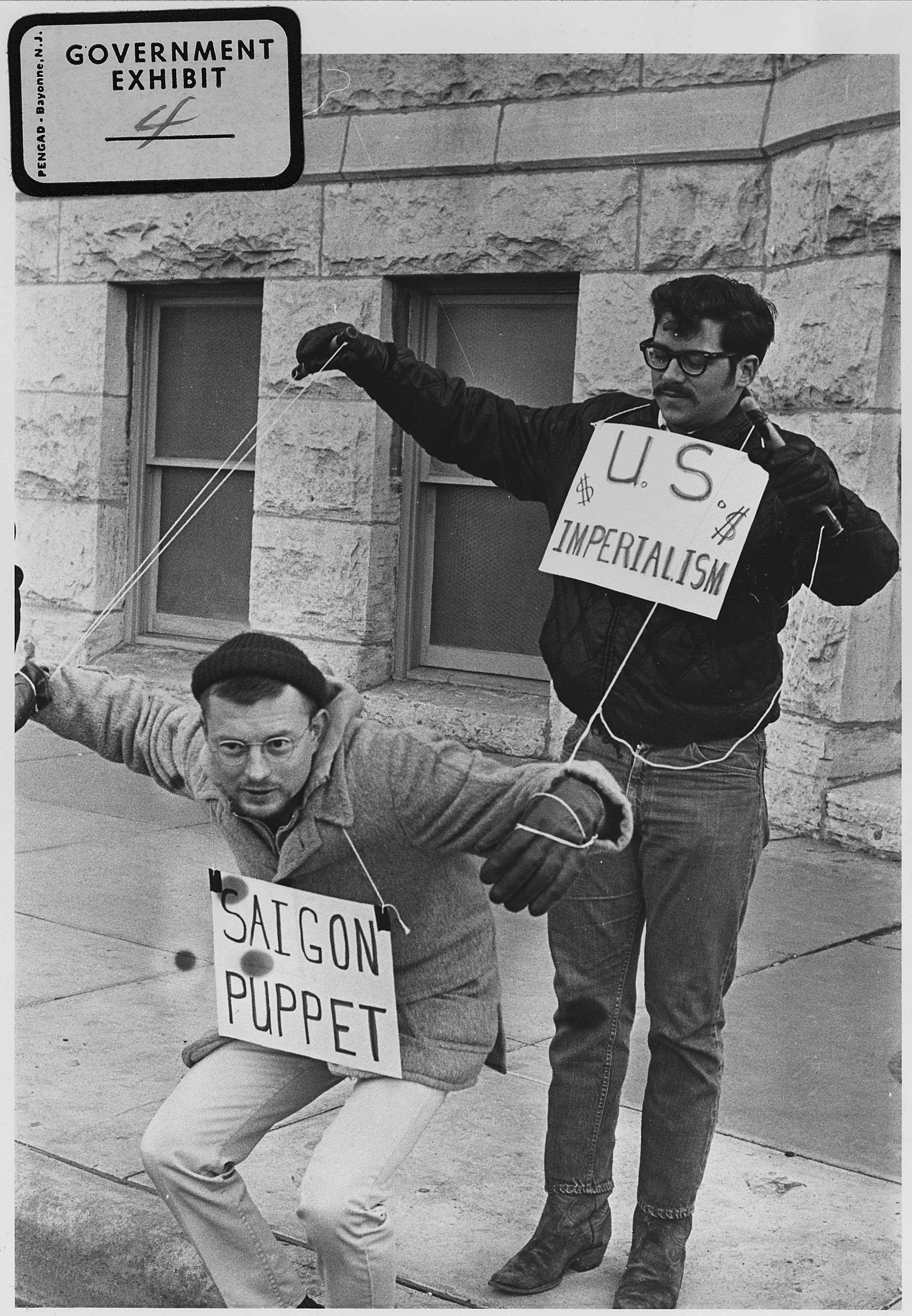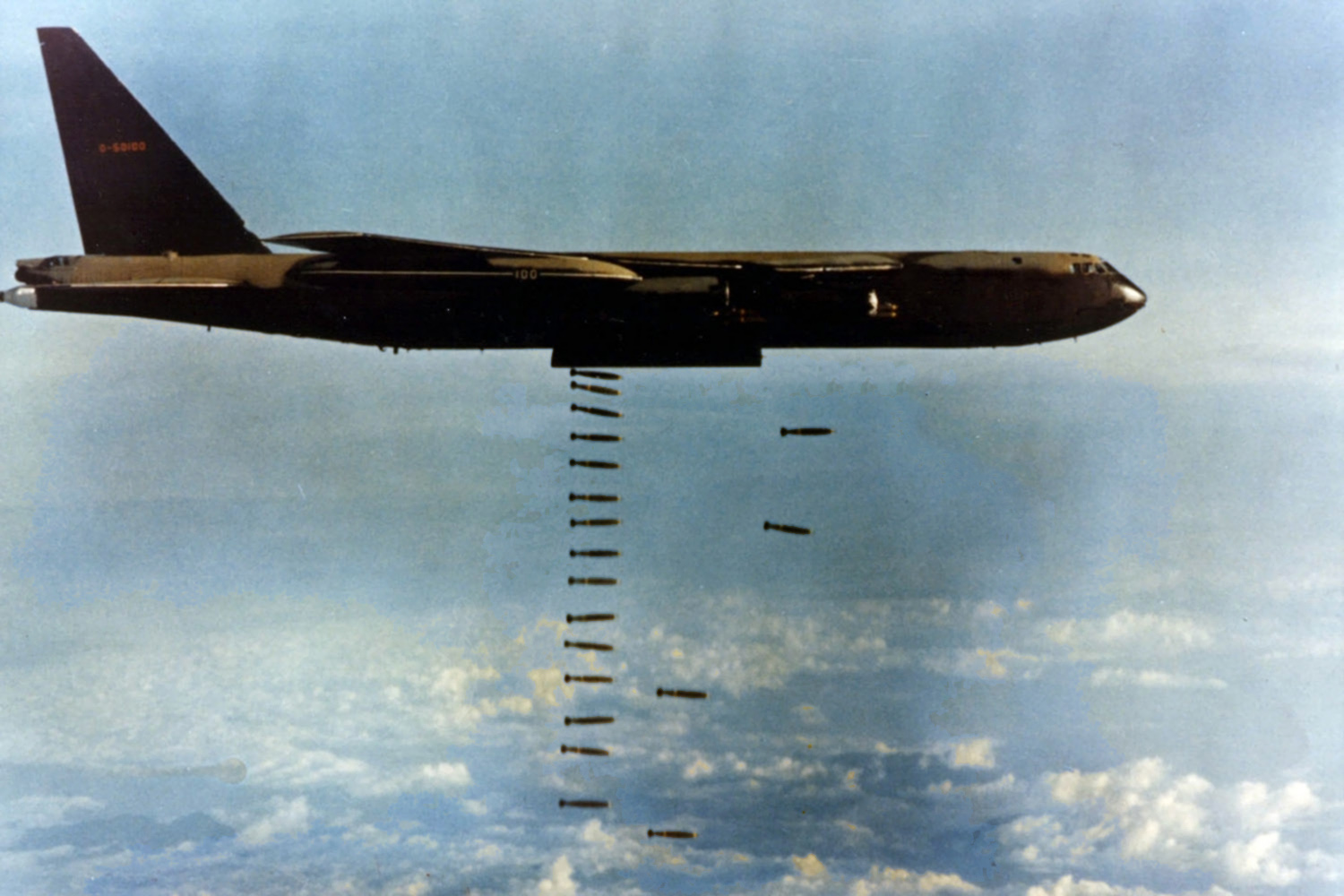The Vietnam War is not only a dark chapter in the history of the USA. It was also one of the country’s longest wars (so far only the deployment in Afghanistan in the wake of 9/11 has lasted longer), and it was the first that the USA lost. It was also the war that influenced the self-image of a nation and its political thinking to a greater extent than virtually any other event. The period of the USA’s direct and indirect engagement in Southeast Asia lasted from 1954 to 1973; the first protests were organized from 1963 and the first large-scale Vietnam protest march took place in Washington D.C. in 1967, attended by 25,000 people.

War protests, Image: U.S. National Archives and Records Administration, [Public domain], via Wikimedia Commons
As one of the first artists to do so, Peter Saul tackled the war as a subject in his paintings from 1965 onwards, having come into contact with the protest movement via the Joan Baez Peace School. In his images, he clearly showed his stance, condemning the USA’s war crimes and creating a bitter social commentary on the present, for example with the images “Yankee Garbage”, “Vietnam” or “Saigon”, which can be seen in the SCHIRN.
A proxy war
As with all wars, in the case of the Vietnam War too, it is not enough to examine merely the actual years of the war to understand its full impact. The years before the war officially broke out are also crucial. The Vietnam War was a proxy war within the Cold War, and thus also part of the far-reaching repercussions of the Second World War.

Following the Second World War, many in the USA and Europe considered communism to be the greatest threat – politically, economically and culturally. Specifically the expansion of the Soviet Union after 1945 quickly led to the emergence of clear opposing parties in the Cold War. Between 1947 and 1989 the western powers (with the USA leading the way) and the Eastern Bloc (under the leadership of the USSR), would not only be a “cold” threat to one another, but would indeed come into genuine “hot” conflicts in proxy wars.
A blueprint for land distribution
In Vietnam the largely communist nationalists, including Ho Chi Minh, hoped to break away from France, the colonial power, following the Second World War. However, the Vietnamese not only had to stand up to the French, but also the Japanese, who were present as a foreign power in the country. In their struggle against the French, Ho Chi Minh and the nationalists sought an ally, which they eventually found in the Soviet Union. The war against France – the so-called Indochina War – lasted from 1946 to 1954. Eventually, at the Geneva Conference in 1954, a north-south division was established for the country based on the blueprint of the division of Korea that had already taken place.
Vietnam - French foreign legionaries with a US-produced tank between Haiphong and Hanoi ca 1954, Image by PIX [Public domain], via Wikimedia Commons
Yet unlike North Korea, communist North Vietnam, which was based on the Soviet model, was not demoralized and weakened; indeed, it was able to draw on military and industrial resources and was ready to embark on a military conflict with South Vietnam. At the beginning of the 1960s President John F. Kennedy initially increased the USA’s presence in South Vietnam from 1,000 to 16,000 advisors. The coup d’état and the murder of Ngo Dinh Diem, the president of South Vietnam, in 1963 meant there was ultimately a power vacuum in the country, which presented an opportunity for the North Vietnamese to attack.
Subsequently revealed as fabricated
After the assassination of President Kennedy in 1963, the new President Lyndon B. Johnson introduced a new political stance on the conflict in Vietnam. In August 1964, Johnson was given the authority, with the help of the Tonkin Resolution, to enter into a war with communist North Vietnam. This was prompted by two attacks on US ships carried out by North Vietnamese boats, although both attacks were subsequently revealed to have been faked. As a consequence, the USA sent ground troops to South Vietnam and carried out huge bombing raids on North Vietnam – more bombs were dropped on Vietnam than during the whole of the Second World War in all the areas of conflict combined. During the course of the war, the USA would build a strong military presence of 500,000 men in Vietnam.

John F. Kennedy about Vietnam in Washington, D. C., 1961, Image by Abbie Rowe, National Park Service [Public domain], via Wikimedia Commons

American long-distance bombers, Image by USAF [Public domain], via Wikimedia Commons
A turning point in the approach by the USA, which was certain of its own victory, came in 1968 with the North Vietnamese Tet offensive (Tet is the Vietnamese new year festival), which involved a surprise attack on South Vietnamese territory. Although this failed in practical terms, the USA was nevertheless considerably weakened psychologically. Back at home in particular, support for the war faded away. The media reported on the undiminished strength of the Viet Cong, and it therefore seemed there was no end to the conflict in sight. The political will to pursue the war on the other side of the Pacific was dwindling.
Abandoned and outgunned
Johnson’s successor Richard Nixon was forced to train more and more South Vietnamese troops, since he was no longer able to recruit enough American soldiers and the first US soldiers already had to be withdrawn. The Vietnam War came to an end in 1973 with the Paris Peace Accords. Vietnam was left to its own devices, and the South Vietnamese were left alone to defend themselves against the North, to which they ultimately surrendered in 1975.

U.S. Marines in action in Vietnam, Image by U.S. Marines (Official Marine Corps Photo # 371490) (http://www.tecom.usmc.mil/HD/Home_Page.htm) [Public domain], via Wikimedia Commons
